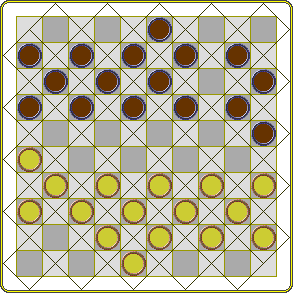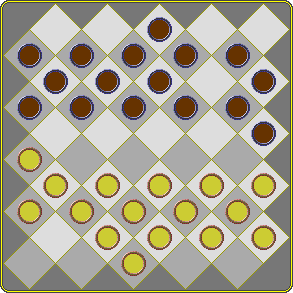In 1932 Frisian Draughts became officially established with the foundation of the DFS (Dambûn Frysk Spul), the Frisian Draughts Association, who organise personal and club championships every year.
Topology
The interesting thing about Frisian is that it goes a roundabout way to get diagonal movement and straight/diagonal capture. That's because it still employs half the grid: topologically speaking there are no light squares in the diagram on the left and we can make them disappear, as shown before in Draughts Dissected.
 |  |
Sure there are light and dark squares in the second diagram, but they are the result of checkering the former dark squares that now fill the board seamlessly
The second representation is an orthogonal grid rotated 45o. Movement is now 'straight', that is: along the orthogonal lines, capture is both straight and 'diagonal', that is: along the dark or light checkered subgrids.
Frisian and Armenian Draughts: evolutionary forerunners
The emergence of Frisian Draughts mirrors the emergence of Armenian Draughts. Frisian turned a diagonal singlegrid game into a doublegrid game by introducing orthogonal capture. If it had been played on the board on the left we would have to say that it turned an orthogonal singlegrid game into a doublegrid game by introducing diagonal capture. It's just a matter of how you look at it.
Armenian Draughts turned an orthogonal singlegrid game, Turkish Draughts, into a doublegrid game by introducing diagonal movement, but the basic change - single to doublegrid - is the same. These games are therewith the first truly modern games. We did mention as much in The split into two branches in the history section. Although somewhat archaïc and tainted with 'corrective modifications' and 'special cases', not to mention Armenian's terrible 'dog on a cookie trail' method of capture, they pointed in the right direction: Draughts needs a doublegrid implementation or it will die like Checkers.
Dameo is the most likely candidate because it is a fast and fuctional modern weapon without any need for corrective modifications or the the covering of special cases. Dameo mirrors Draughts beauty and combinatorial power, but it is faster and far less drawish, regardless of the strength of the players.
